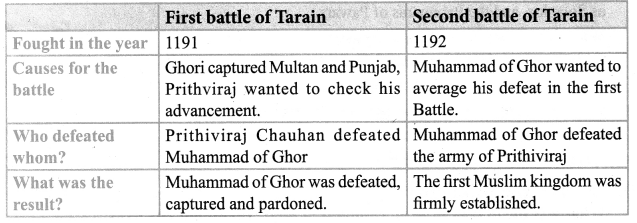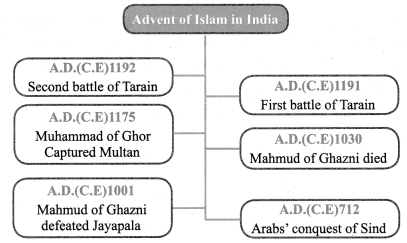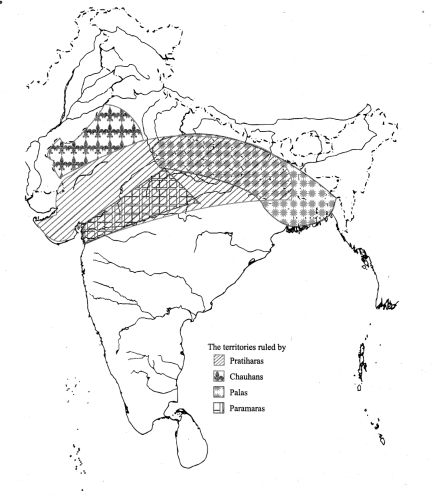Students can Download Social Science History Chapter 2 Emergence Of New Kingdoms In North India Questions and Answers, Notes Pdf, Samacheer Kalvi 7th Social Science Book Solutions Guide Pdf helps you to revise the complete Tamilnadu State Board New Syllabus and score more marks in your examinations.
Tamilnadu Samacheer Kalvi 7th Social Science History Solutions Term 1 Chapter 2 Emergence Of New Kingdoms In North India
Samacheer Kalvi 7th Social Science Emergence Of New Kingdoms In North India Textual Evaluation
I. Choose the correct answer:
Question 1.
Who wrote Prithivirajraso?
(a) Kalhana
(b) Vishakadatta
(c) Rajasekara
(d) Chand Bardai
Answer:
(d) Chand Bardai
Question 2.
Who was the first prominent ruler of Pratiharas?
(a) Bhoja I
(b) Naga Bhatta I
(c) Jayapala
(d) Chandradeva
Answer:
(b) Naga Bhatta 1
Question 3.
Ghazni was a small principality in
(a) Mangolia
(b) Turkey
(c) Persia
(d) Afghanistan
Answer:
(d) Afghanistan
![]()
Question 4.
What was the most important cause of the invasion of Mahmud of Ghazni?
(a) To destroy idolatry
(b) To plunder the wealth of India
(c) To spread Islam in India
(d) To establish a Muslim state in India
Answer:
(b) To plunder the wealth of India
II. Fill in the Blanks
- ______ was the founder of Vikramashila University.
- Arabs conquered Sind in ______
- The city of Ajmeer was founded by ______
- The Khandarya temple is in ______
Answer:
- Dharmapala
- AD (CE) 712
- Simharaji
- Madhya Pradesh
III. Match the following
|
A |
B |
|
| 1. Khajuraho | i | Mount Abu |
| 2. Sun Temple | ii | Bundelkhand |
| 3. Dilwara Temple | iii | Konark |
Answer:
- ii
- iii
- i
IV. True or False:
Question 1.
Rajputra is a Latin word.
Answer:
False
Correct statement: Rajputra is a Sanskrit word.
Question 2.
King Gopala was elected by the people.
Answer:
True
![]()
Question 3.
The temple at Mount Abu is dedicated to Lord Shiva.
Answer:
False
Correct statement: The temple at Mount Abu is dedicated to Jain Tirthankaras.
Question 4.
Raksha Bandhan is a festival of brotherhood.
Answer:
True
Question 5.
Indians learned the numerals 0 – 9 from Arabs.
Answer:
False
Correct statement: Arabians learned the numerals 0-9 from Indians.
V. Consider the following statements.
Tick (✓) the appropriate answer.
Question 1.
Assertion (A): The tripartite struggle was to have control over Kanauj.
Reason (R): Kanauj was a big city.
(a) R is the correct explanation of A.
(b) R is not the correct explanation of A.
(c) A is wrong and R is correct.
(d) A and R are wrong.
Answer:
(b) R is not the correct explanation of A
![]()
Question 2.
Statement I: Mahipala could not extend his domain beyond Benaras.
Statement II: Mahipala and Rajendra Chola were contemporaries.
(a) I is correct
(b) II is correct.
(c) I and II are correct
(d) I and II are false
Answer:
(c) I and II are correct.
Question 3.
Assertion (A): India’s Islamic period did not begin after the Arab conquest of Sind in AD (CE)712.
Reason (R): Gurjara Pratiharas gave stiff resistance to Arabs.
(a) R is the correct explanation of A.
(b) R is not the correct explanation of A.
(c) A is correct and R is wrong.
(d) A is wrong and R is correct.
Answer:
(a) R is the correct explanation of A
Question 4.
Assertion (A) : The second battle of Tarain was lost by Prithiviraj.
Reason (R) : There was disunity among the Rajputs
(a) R is the correct explanation of A.
(b) R is not the correct explanation of A.
(c) A is correct and R is wrong.
(d) A is wrong and R is correct.
Answer:
(c) A is correct and R is wrong.
Question 5.
Consider the following statements and find out which is/are correct.
- Raksha Bandhan tradition is attributed to Rajputs.
- Tagore started a mass Raksha Bandan festival during Partition of Bengal
- Raksha Bandan was to counter the British attempt to create a divide between Hindus and Muslims.
(a) 1 is correct
(b) 2 is correct
(c) 3 is correct
(d) All the above are correct
Answer:
(d) All the above are correct
VI. Answer in one or two sentences
Question 1.
Write about the tripartite struggle over Kanauj.
Answer:
There was a prolonged tripartite struggle between the Gurjara Pratiharas of Malwa, the Rashtrakutas of Deccan, and the Palas of Bengal, as each one of them wanted to establish their supremacy over the fertile region of Kanauj. In the process, all three powers were weakened.
![]()
Question 2.
Name any four Rajput clans.
Answer:
The Pratiharas, the Chauhans, the Chalukyas (different from the Deccan Chalukyas), known as Solankis, and the Paramaras of Pawar’s.
Question 3.
Who was the founder of the Pala dynasty?
Answer:
Gopala was the founder of the Pala dynasty.
Question 4.
Mention the first two early Caliphates.
Answer:
Two early Caliphates were ‘Umayyads’ and the ‘Abbasids’
Question 5.
Name the ruler of Sind who was defeated by Qasim.
Answer:
Qasim defeated Dahir, the ruler of sind, and killed him in the battle.
VII. Answer the following :
Question 1.
What was the impact of the Arab conquest of Sind? (point out any five)
Answer:
- The people of Sind were given the status of ‘protected subjects’.
- There was no interference in the lives and religions of the people.
- Arab scholars visited Sind and studied many Indian literary works.
- They translated many Sanskrit books on astronomy, philosophy, mathematics, and medicine into Arabic.
- They learned the numerals 0 to 9 from India. Until then, the people in the West did not know the use of zero.
- Through the Arabs, Europe gained more knowledge in mathematics. The importance of zero was learned by them from India.
- It is believed that the people in the West and the Arabs learned the game of chess only from the Indians.
![]()
VIII. HOTS:
Question a.
Difference between Mahmud Ghazni’s invasion and Muhammad Ghor’s invasion.
Answer:
Mahmud Ghazni’s Invasion:
- Muhamud of Ghazni aimed at plundering rich temples and cities of India.
- He conducted 17 raids.
- He returned Ghazini with enormous riches.
Muhammad Ghor’s Invasion:
- Muhammed Ghor aimed to extend his empire.
- He conquered continuously.
- He established the Muslim kingdom in India.
Question b.
Find out

Answer:

IX. Student Activity :
Question a.
Word Splash (Students discuss what they know about the words given here. They use the words from what they have learnt in a narrative form)
(Harsha, Rajput,Kanauj,Vikramashila,Prithiviraj,Caliph)
Answer:
Harsha: Harsha also known as Harsha Vardhan was an Indian emperor who ruled North India from 606 to 647 A.D.
Kanauj: Kanauj was a fertile region. It was the capital of Gujarat Prathikaras.
Prithiviraj: Prithiviraj Chauhan was considered the greatest ruler of all Chauhan rulers. He gave the Strong resistance against Arabs. He won the First Battle of Tarain in 1191 against Muhammad Ghor.
Rajputs: Rajputs were the strong and brave clans of North India. The Rajput chiefs strongly opposed the Arab invaders. They contributed a different kind of art and architecture to Indian Culture.
Vikramashila: Vikramashila was a monastery, which became a great centre of Buddhist learning. Dharmapala founded Vikramashila Monastery.
Caliph: Caliph means a representative of the prophet Muhammad. He was a religious and political leader of the Islamic state.
Question b.
TimeLine
Write the event for the given year in each column.

X. Map work
On the river map of India mark the territories ruled by Pratiharas, Chauhans, Palas and Paramaras

XI. Answer Grid

XII. Life skill :
Question 1.
Make an album with pictures of temples built by Rajput rulers.
Answer:
Activity to be done by the students themselves
Samacheer Kalvi 7th Social Science Emergence Of New Kingdoms In North India Additional Questions
I. Choose the correct answer:
Question 1.
was prominent and had become the rallying point for all Rajput clans.
(a) Kanauj
(b) Ajmer
(c) Chittor
(d) Sind
Answer:
(c) Chittor
![]()
Question 2.
Chandelas ruled at
a) Haryana
b) Bundelkhand
c) Gujarat
d) Punjab
Answer:
b) Bundelkhand
Question 3.
was also a great patron of Buddhism.
(a) Gopala
(b) Mahipala
(c) Devapala
(d) Harsha
Answer:
(c) Devapala
Question 4.
There are sixteen Hindu and Jain temples at which is 32 miles away from Jodhpur.
(a) Osian
(b) Jaipur
(c) Udaipur
(d) Gwalior
Answer:
(a) Osian
II. Fill in the blanks:
- ______ laid the foundation of the Gurjara dynasty.
- ______, son of Rambhadra, succeeded in consolidating the power of the Pratiharas.
- ______ was the most powerful ruler of the Pala dynasty.
- The______ of the Khajuraho temples are most elegant.
- Under Pala patronage, a distinctive school of art arose, called ______
Answer:
- Harichandra
- Mihirabhoja
- Mahipala I
- Shikharas
- Pala Art or Eastern Indian Art
III. Match the following:
| A | B | ||
| a. | Harichandra | i. | Rajput dynasty |
| b. | Gopala | ii. | Political leader |
| c. | Simharaji | iii. | Pala dynasty |
| d. | Caliphates | iv. | Guijara dynasty |
Answer:
- iv
- iii
- i
- ii
IV. True or False:
Question 1.
The Pala dynasty declined soon after the death of Mahipala.
Answer:
True
Question 2.
The Khajuraho temples are dedicated to Buddha.
Answer:
(False) Correct statement: The Khajuraho temples are dedicated to Shiva and Vishnu.
Question 3.
The Palas were adherents to the Mahayana school of Buddhism.
Answer:
True
![]()
Question 4.
Mahmud is said to have conducted 10 raids into India.
Answer:
(False) Correct statement: Mahmud is said to have conducted 17 raids into India.
V. Match the statement with the reason. Tick the appropriate answer:
Question 1.
Statement: King of Kanauj placed a statue of Prithviraj as doorkeeper at the entrance to his court.
Reason: He wanted to insult Prithiviraj.
(a) Statement is correct, Reason is wrong.
(b) Statement is wrong, Reason is correct.
(c) Statement and Reason are correct.
(d) Statement and Reason are wrong.
Answer:
(c) Statement and Reason are correct.
Question 2.
Statement: After the victory in the second battle of Tarain Muhammad Ghori returned to Ghazni.
Reason: He had a weak army.
(a) Statement and Reason are wrong.
(b) Statement is correct and Reason is wrong.
(c) Reason is correct, Statement is wrong.
(d) Statement and Reason are correct.
Answer:
(b) Statement is correct and Reason is wrong.
![]()
Question 3.
Find out the wrong Pair
(a) Suryavanshi – i. Race of the Sun
(b) Chandravanshi – ii. Race of the Moon
(c) Agnikula – iii. Race of the Sky
(d) Tomaras – iv. Haryana region
Answer:
(c) Agnikula – Race of the Sky
VI. Answer in one word.
Question 1.
Name the tower of victory built in Chittoor to commemorate the victory of Rana of Chittor over Malwa.
Answer:
Jaya Stambha
Question 2.
Who is the Chola king who restricted the Pala domain from spreading beyond Banaras?
Answer:
Rajendra Chola
Question 3.
What was the capital of Chauhans between A.D. 956 and 1192?
Answer:
Sakambari.
VII. Answer the following :
Question 1.
Explain the origin Theory of Rajputs.
Answer:
The word ‘Rajput’ is derived from the Sanskrit word Rajputra, which means scion of the royal blood’. Their three Principal houses of Rajputs are the Suryavanshi or the Race of the Sun, the Chandravanshi or the Race of the Moon, and the Agnikula or the Race of the Fire God. Thirty – six royal Rajput clans were listed by James Tod in 1829. Among the four claimed important status the Pratiharas, the Chauhans, the Chalukyas, the Solankis, and the Paramaras.
Question 2.
Write a short note on Khajuraho temples.
Answer:
The Khajuraho in Bundelkhand has 30 temples. The shikhara of the Khajuraho temples are most elegant. The exterior and interior parts of the temples are adorned with very fine sculptures. These temples are dedicated to Jain Tirthankaras and Hindu deities like Shiva and Vishnu.
![]()
Question 3.
Name the famous universities of the Palas period.
Answer:
Famous universities of Nalanda and Vikramashila.
Question 4.
Who was the Buddhist monk who reformed Tibetan Buddhism?
Answer:
Atisha
VIII. HOTS:
Question 1.
What is the significance of the Rakhi or Raksha Bandhan festival?
Answer:
This festival celebrates brotherhood whereby a woman ties a rakhi around the wrists of men whom they treat as brothers with a belief that they would protect them. Rabindranath Tagore started the mass Raksha Bandhan festival to encourage brotherhood and harmony between Hindus and Muslims during the partition of Bengal.